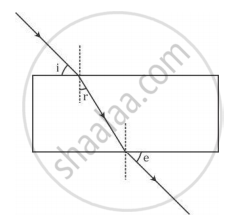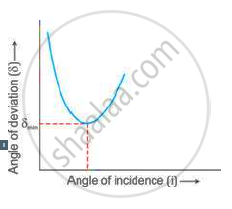Advertisements
Advertisements
Question
A student traces the path of a ray of light passing through a rectangular glass slab and marks the angle of incidence i, angle of refraction r and angle of emergence e, as shown.

The correctly marked angle(s) is/are
(A) ∠ i only
(B) ∠ e only
(C) ∠ r only
(D) ∠ i and ∠ e
Solution
Angle of incidence, angle of refraction and angle of emergence, all are measured from the normal to the surface. Therefore, only angle of refraction, ∠r is marked correctly.
Hence,the correct option is C.
APPEARS IN
RELATED QUESTIONS
Why is the ratio of the velocities of light of wavelengths 4000Å and 8000Å in vacuum 1: 1?
How is the reflection of light ray from a plane mirror different from the refraction of light ray as it enters a block of glass?
A monochromatic ray of light passes from air to glass. The wavelength of light in air is λ, the speed of light in air is c and in glass is V. If the absolute refractive index of glass is 1.5, write down
- the relationship between c and V,
- the wavelength of light in glass.
A postage stamp kept below a rectangular glass block of refractive index 1.5 when viewed from vertically above it, appears to be raised by 7.0 mm. Calculate the thickness of the glass slab.
Draw an í- `delta` graph for a mono chromatic raY through a glass prism of a plane and mark
(i) `delta` m, the angle of mínimum devíation
(íí) Any two values of i for which value of `delta` ís same.
Using the curve, how do you infer that for given prism, the angle of minimum deviation δmin is unique for the given light?

The refractive index of air with respect to glass is defined: as gµa = sin i/sin r
Write down a similar expression for aµg in terms of angle i and r.
Observe the figure and name the ray AB, ray CD, ray GH.

